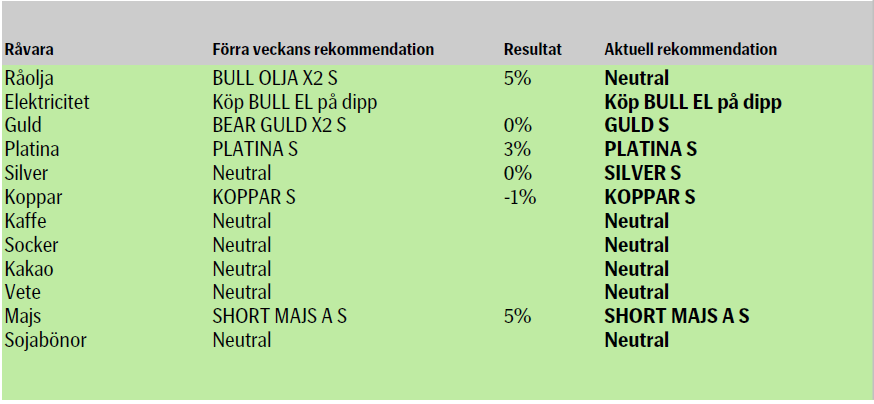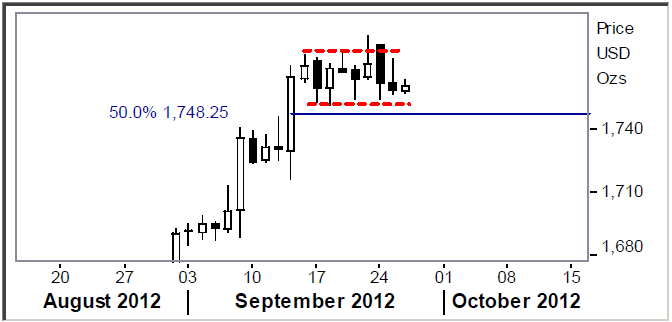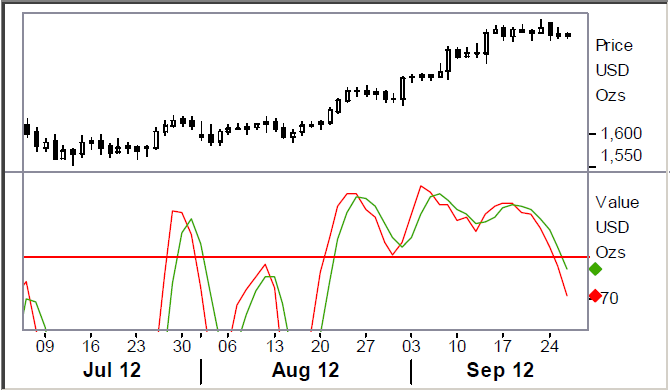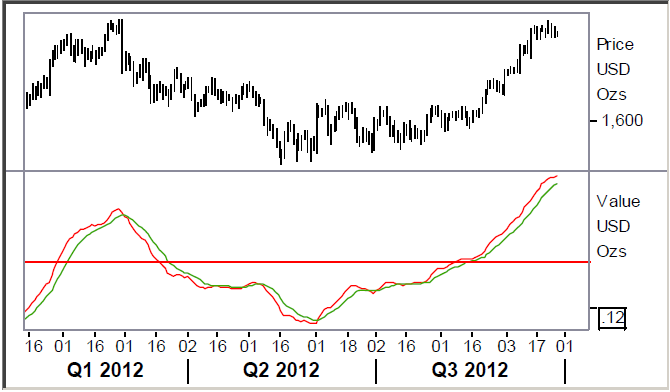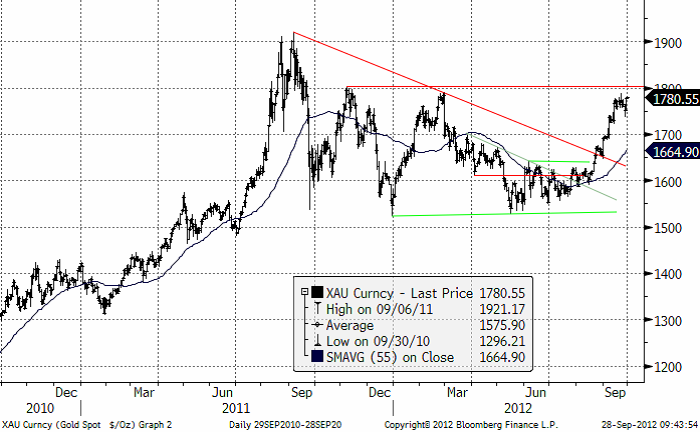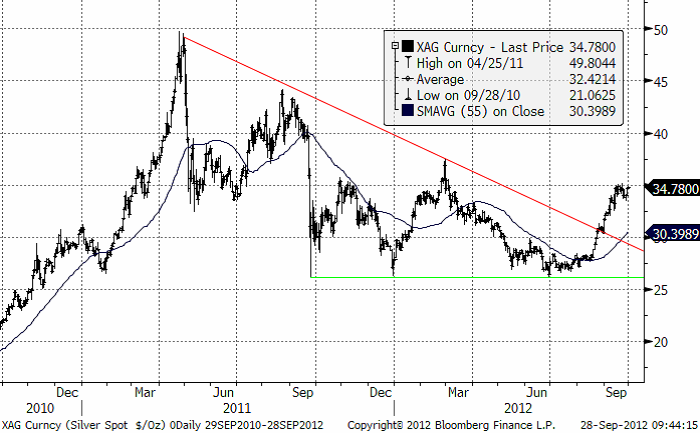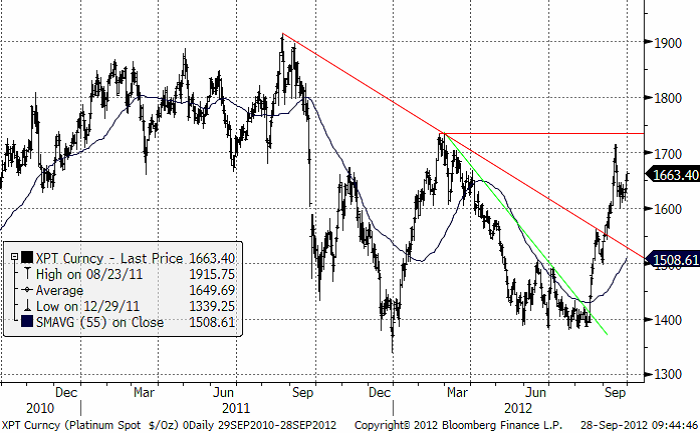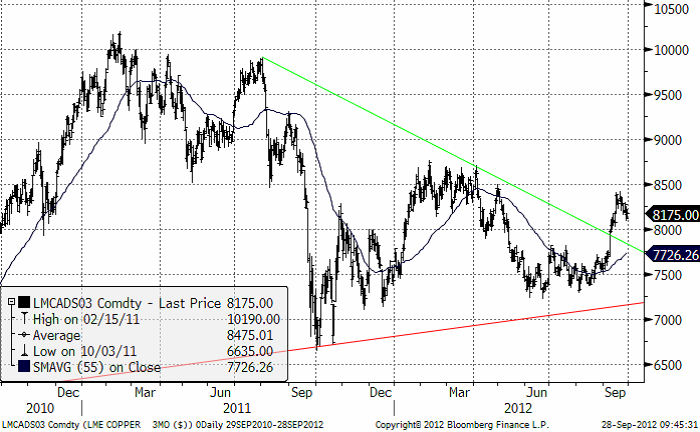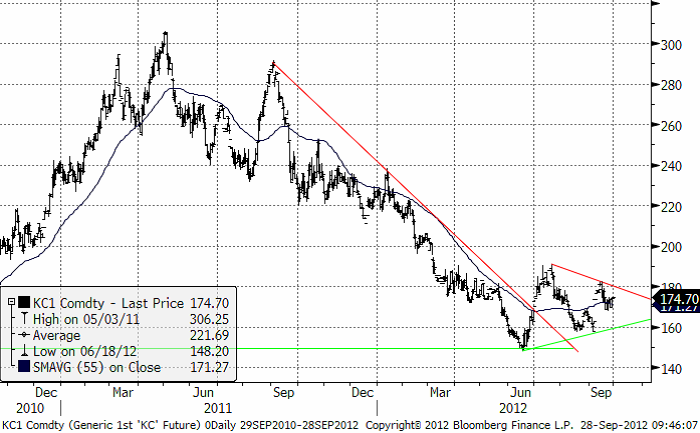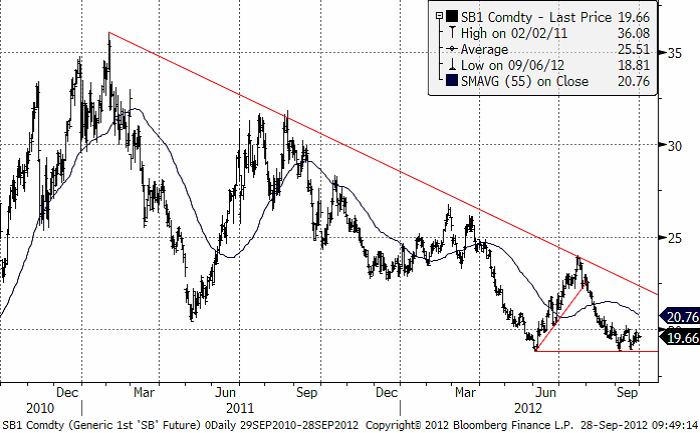Analys
SEB – Råvarukommentarer, 28 september 2012
Sammanfattning av rekommendationer
Summan av resultatet blev vinst på 12%, efter förra veckans förlust på -1%.
Viktigast den här veckan är att vi tror att det kan komma en rekyl i guldpriset. Det ser ut så rent tekniskt. Priset har rusat iväg väldigt fort och är uppe på nivåer där det sannolikt finns många som vill ta hem vinster. Vi ser detta som en teknisk och kortsiktig rekyl. Vi anser att det finns gott om värde i Platina och väljer att ligga kvar köpta den, samtidigt som vi mycket kortsiktigt rekommenderar en kort position i guld. Råolja går vi över till neutral rekommendation på, liksom på silver, som ligger någonstans mellan guld och platina i vår vy nu.
Jordbruksprodukterna är vi neutrala till negativa till. Det kommer viktig lagerstatistik från USDA senare idag, som är värt att hålla koll på. Kaffe, socker och kakao ligger alla lågt i pris, och tycks bilda bottenformationer inför en eventuell trendvändning. För närvarande är vi neutrala.
Råolja – Brent
Det blev ingen omedelbar prisuppgång i Brentolja efter USAs tredje omgång av kvantitativa lättnader. Brentoljan faktiskt har fallit snarare än motsatsen. Den främsta orsaken till detta är på den ökande oron över situationen i Europa vilket resulterar i en starkare USD och en svagare euro. Medan Mellanösterns försörjningsavbrott och olösta situationen håller oljepriset sig högt men den grundläggande makrobilden ser svag ut och drar i baisseriktning. Vi har en neutral syn på Brentolja för närvarande till ett pris av $ 110 / b. Saudiarabien skulle gärna se att oljepriset blev lägre i syfte att lindra den globala makrosituationen men har inte lyckats hittills. Saudiarabien fortsätter dock att försöka hålla ner oljepriset genom att hålla sin oljeproduktion på en förhöjd nivå.
I nuläget förhåller vi oss neutral men ser nivåer kring 105 USD som en mycket attraktiv nivå för en lång position.
Elektricitet
Elmarknaden föll genom stödet, men vände sedan upp igen och ligger nu precis under motståndet. Den kortsiktiga trenden är nedåtriktad och vi ser uppgången som en rekyl. Ser vi till marknaden för kol, vars pris helt och hållet styr priset på el i Norden, är den marknaden i en tydlig nedåttrend sedan en topp i början på augusti. Däremot är priset på kol nere på en nivå, där priset funnit stöd flera gånger förut, i maj, juni och juli. Marknaden testar alltså historiska bottennivåer i såväl kol som el. Vi har ännu inte en köprekommendation, utan behåller neutral rekommendation.
Vidare kan nämnas att väderleksrapporten visar riklig nederbörd, reservoarerna är på 5-årshögsta och hydrobalansen är 12 till 15 TWh över det normala. Nordiska kärnkraftverk väntas vara helt online från den 26 oktober och global ekonomisk aktivitet minskar såväl i Asien som i Europa och är svag och oförutsägbar i USA. Detta gör att vi är oroliga för ytterligare nedsida i elpriset. Icke desto mindre, handlas kontraktet för det första kvartalets genomsnittliga spotpris för 2013, som är underliggande för våra ETN:er, nära 40 euro per MWh, som vi anser är ett bra pris inför vintern. Första kvartalet är trots allt det kallaste kvartalet. Det finns möjligheter till kortsiktiga uppgångar till 44 euro.
Guld och Silver
Efter den initiala reaktionen efter FED har guld och silver inte orkat klättra vidare. Många aktörer som köpt på förväntningar om ytterligare stimulanser har legat beredda att ta hem vinster. Det gamla ordspråket ”buy the rumour and sell the fact” verkar gälla även den här veckan. Undertonen är ändå stark och rekylerna endast marginella. Vi bedömer att priserna har fortsatt mer att ge med nivån $1800 inom räckhåll för guld (spot i London handlas kring $1862 i skrivandes stund). En tänkbar strategi (för den som inte redan köpt) är att bevaka den tidigare högsta nivån $1780 och agera på ett genombrott. Scenariot är likartat för silver med rekommenderad bevakning av förra veckans toppnivå på $35/oz ($34,50 i skrivandes stund). Vår tekniska analys indikerar en större rekyl på nedsidan om nivån 1748 bryts på stängningsbasis. Se våra tekniska kommentarer nedan:
Bankens tekniska analytiker menar så här: “Last Friday printed an up-thrust top, a false break higher. The move was on Monday followed by a gap higher and an immediate reversal creating a bearish engulfing/key day reversal candle. A break below 1752 will confirm at least a short term top formation (and more so breaking below the mid body pt, 1748, of the latest rising benchmark candle).” Dessutom ser man en divergens mellan den tekniska indikatorn stochastics, som ofta används som en överköpt/översåldindikator:
“There is a confirmed bear divergence between price and stochastic i.e. a higher top in price and a lower one in the indicator”. Vi ser en bild på detta nedan:
En annan teknisk indikator, MACD, visar på en överköpt marknad, som vi ser i nedanstående diagram, samtidigt som priset på guld ligger väldigt nära toppnivåerna från det första kvartalet.
Nedan ser vi lite längre historik för guld i dollar per troy ounce.
Nedan ser vi kursdiagrammet för silver i dollar per troy ounce, som ligger precis under 35 dollar. Vi har sett att det verkar finnas säljare på 35 dollar.
Platina
Trots strejkslutet vid Lonmins gruva i Sydafrika vände marknaden uppåt i veckan. Spotnoteringen i London är upp ca 1,5 % sen förra fredagen. Lonmin har finansiella problem och strejkvågen riskerar att sprida sig till andra platinagruvor. Flera guldgruvor har produktionsstopp p.g.a. nya strejker. Risken är stor för minskat utbud från regionen. Den industriella efterfrågan är relativt svag i Europa men fordonsindustrin i Kina förväntas skapa god tillväxt. Vi kvarstår med köprekommendationen.
Nedan ser vi priset på guld dividerat med priset på platina. Vi ser att guld har utvecklats sämre än platina sedan mitten avaugusti. Tekniskt ser den här trenden stark ut och har potential att gå från 1.05 till 1, dvs en outperformance på ytterligare 7%till platinas fördel. Som vi ser av den längre historiken brukar platina vara betydligt dyrare än guld. Dagens rabatt på platina iförhållande till guld är väldigt ovanlig.
Koppar
Prisutvecklingen har varit lite ”tråkig” för basmetallerna under veckan. Fokus har återigen skiftat tillbaka till Europa. Preliminära PMI- siffror från Eurozonen kom in lägre än väntat, 45,9 mot 46,3 förra månaden. IFO-Index (företagsklimatet) från Tyskland ingav inte heller något ökat förtroende. Ingen viktig statistik från Kina, men marknaden känner sig tveksam till aktiviteten där just nu. Det är egentligen bara US som faktiskt visar positiva tecken, på den för den amerikanska ekonomin så viktiga bostadsmarknaden, som nu verkar ha bottnat ur.
Basmetallerna handlades med blandad tendens under veckan. Koppar föll, aluminium och zink höll sig oförändrade, medan nickel visar styrka just nu och är upp 2 %.
När det gäller koppar, räknade vi med en stabilisering efter rekylen i förra veckan och därefter nya försök på uppsidan, men marknaden har inte haft kraft nog. Priset har istället fallit ca 1 %. Vi kvarstår med bedömningen att det mesta talar för en fortsatt stark underton. Den kan dock dröja lite till innan en ny rusning. Nya signaler från Kina är nog vad som behövs. Kina konsumerar 40 % av världens koppar.
Vi bedömer att finansiella aktörer som tidigare spekulerat i nedgång, nu har återköpt positioner. Tekniska fonder har börjat gå långa. Industrin är än så länge avvaktande och brottas med en prisuppgång som inte riktigt speglar den fundamentala situationen, och i många fall överstiger lagda budgetnivåer. Frågan är när (och om) industrin tvingas ”bita i det sura äpplet” och täcka in framtida behov. Centralbankerna visar att de menar allvar och stimulanserna fortsätter. Aktörerna väntar på mer från Kina. Mycket talar för en fortsatt stark trend i nästa vecka med test av nivåer upp mot $8500.
Vi väljer att på kort sikt rekommendera en lång position i koppar.
Kaffe
Kaffepriset har rekylerat ner från toppen tidigare i månaden, men funnit stöd vid 55 dagars glidande medelvärde. Tekniskt noterar vi att det efter bottennoteringen i juni på 148 cent, har en tid av konsolidering i marknaden bildat en triangelformation. Triangelformationer kan ofta signalera en trendvändning uppåt, som bekräftas av ett brott uppåt i så fall. Triangelformationen är ett observandum. Vi behåller en neutral rekommendation i väntan på brott uppåt – eller nedåt från formationen, som du kan se inritad i diagrammet nedan.
Socker
Marknaden för socker pressas av ideliga dåliga nyheter. Till exempel väntas nu det tredje året med överskott (lageruppbyggnad) pga hög produktion. Priset tycks dock inte ta mycket intryck av detta, utan håller det tekniska stödet, än så länge.
Kakao
Kakaopriset har fortsatt falla ner mot stödområdet. Vi behåller förra veckans neutrala rekommendation.
Stocks report idag från det amerikanska jordbruksdepartementet
Idag, fredag publicerar USDA stocksrapporten per den 1 september. Vi har sammanställt marknadens förväntningar från analytikers bidrag till Bloomberg och du ser dem i tabellen nedan:
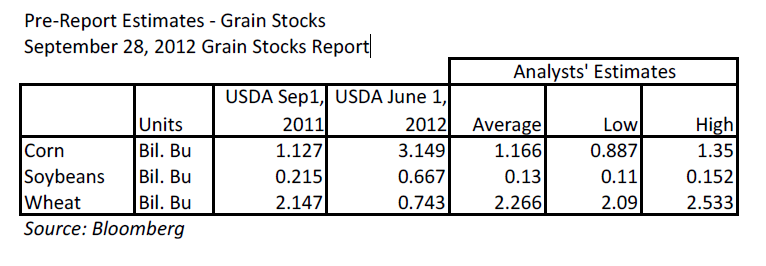 För spannmål och övriga jordbruksprodukter hänvisas till gårdagens nyhetsbrev om jordruksprodukter.
För spannmål och övriga jordbruksprodukter hänvisas till gårdagens nyhetsbrev om jordruksprodukter.
[box]SEB Veckobrev Veckans råvarukommentar är producerat av SEB Merchant Banking och publiceras i samarbete och med tillstånd på Råvarumarknaden.se[/box]
Disclaimer
The information in this document has been compiled by SEB Merchant Banking, a division within Skandinaviska Enskilda Banken AB (publ) (“SEB”).
Opinions contained in this report represent the bank’s present opinion only and are subject to change without notice. All information contained in this report has been compiled in good faith from sources believed to be reliable. However, no representation or warranty, expressed or implied, is made with respect to the completeness or accuracy of its contents and the information is not to be relied upon as authoritative. Anyone considering taking actions based upon the content of this document is urged to base his or her investment decisions upon such investigations as he or she deems necessary. This document is being provided as information only, and no specific actions are being solicited as a result of it; to the extent permitted by law, no liability whatsoever is accepted for any direct or consequential loss arising from use of this document or its contents.
About SEB
SEB is a public company incorporated in Stockholm, Sweden, with limited liability. It is a participant at major Nordic and other European Regulated Markets and Multilateral Trading Facilities (as well as some non-European equivalent markets) for trading in financial instruments, such as markets operated by NASDAQ OMX, NYSE Euronext, London Stock Exchange, Deutsche Börse, Swiss Exchanges, Turquoise and Chi-X. SEB is authorized and regulated by Finansinspektionen in Sweden; it is authorized and subject to limited regulation by the Financial Services Authority for the conduct of designated investment business in the UK, and is subject to the provisions of relevant regulators in all other jurisdictions where SEB conducts operations. SEB Merchant Banking. All rights reserved.
Analys
Brent crude ticks higher on tension, but market structure stays soft

Brent crude has climbed roughly USD 1.5-2 per barrel since Friday, yet falling USD 0.3 per barrel this mornig and currently trading near USD 67.25/bbl after yesterday’s climb. While the rally reflects short-term geopolitical tension, price action has been choppy, and crude remains locked in a broader range – caught between supply-side pressure and spot resilience.

Prices have been supported by renewed Ukrainian drone strikes targeting Russian infrastructure. Over the weekend, falling debris triggered a fire at the 20mtpa Kirishi refinery, following last week’s attack on the key Primorsk terminal.
Argus estimates that these attacks have halted ish 300 kbl/d of Russian refining capacity in August and September. While the market impact is limited for now, the action signals Kyiv’s growing willingness to disrupt oil flows – supporting a soft geopolitical floor under prices.
The political environment is shifting: the EU is reportedly considering sanctions on Indian and Chinese firms facilitating Russian crude flows, while the U.S. has so far held back – despite Bessent warning that any action from Washington depends on broader European participation. Senator Graham has also publicly criticized NATO members like Slovakia and Hungary for continuing Russian oil imports.
It’s worth noting that China and India remain the two largest buyers of Russian barrels since the invasion of Ukraine. While New Delhi has been hit with 50% secondary tariffs, Beijing has been spared so far.
Still, the broader supply/demand balance leans bearish. Futures markets reflect this: Brent’s prompt spread (gauge of near-term tightness) has narrowed to the current USD 0.42/bl, down from USD 0.96/bl two months ago, pointing to weakening backwardation.
This aligns with expectations for a record surplus in 2026, largely driven by the faster-than-anticipated return of OPEC+ barrels to market. OPEC+ is gathering in Vienna this week to begin revising member production capacity estimates – setting the stage for new output baselines from 2027. The group aims to agree on how to define “maximum sustainable capacity,” with a proposal expected by year-end.
While the IEA pegs OPEC+ capacity at 47.9 million barrels per day, actual output in August was only 42.4 million barrels per day. Disagreements over data and quota fairness (especially from Iraq and Nigeria) have already delayed this process. Angola even quit the group last year after being assigned a lower target than expected. It also remains unclear whether Russia and Iraq can regain earlier output levels due to infrastructure constraints.
Also, macro remains another key driver this week. A 25bp Fed rate cut is widely expected tomorrow (Wednesday), and commodities in general could benefit a potential cut.
Summing up: Brent crude continues to drift sideways, finding near-term support from geopolitics and refining strength. But with surplus building and market structure softening, the upside may remain capped.
Analys
Volatile but going nowhere. Brent crude circles USD 66 as market weighs surplus vs risk

Brent crude is essentially flat on the week, but after a volatile ride. Prices started Monday near USD 65.5/bl, climbed steadily to a mid-week high of USD 67.8/bl on Wednesday evening, before falling sharply – losing about USD 2/bl during Thursday’s session.

Brent is currently trading around USD 65.8/bl, right back where it began. The volatility reflects the market’s ongoing struggle to balance growing surplus risks against persistent geopolitical uncertainty and resilient refined product margins. Thursday’s slide snapped a three-day rally and came largely in response to a string of bearish signals, most notably from the IEA’s updated short-term outlook.
The IEA now projects record global oversupply in 2026, reinforcing concerns flagged earlier by the U.S. EIA, which already sees inventories building this quarter. The forecast comes just days after OPEC+ confirmed it will continue returning idle barrels to the market in October – albeit at a slower pace of +137,000 bl/d. While modest, the move underscores a steady push to reclaim market share and adds to supply-side pressure into year-end.
Thursday’s price drop also followed geopolitical incidences: Israeli airstrikes reportedly targeted Hamas leadership in Doha, while Russian drones crossed into Polish airspace – events that initially sent crude higher as traders covered short positions.
Yet, sentiment remains broadly cautious. Strong refining margins and low inventories at key pricing hubs like Europe continue to support the downside. Chinese stockpiling of discounted Russian barrels and tightness in refined product markets – especially diesel – are also lending support.
On the demand side, the IEA revised up its 2025 global demand growth forecast by 60,000 bl/d to 740,000 bl/d YoY, while leaving 2026 unchanged at 698,000 bl/d. Interestingly, the agency also signaled that its next long-term report could show global oil demand rising through 2050.
Meanwhile, OPEC offered a contrasting view in its latest Monthly Oil Market Report, maintaining expectations for a supply deficit both this year and next, even as its members raise output. The group kept its demand growth estimates for 2025 and 2026 unchanged at 1.29 million bl/d and 1.38 million bl/d, respectively.
We continue to watch whether the bearish supply outlook will outweigh geopolitical risk, and if Brent can continue to find support above USD 65/bl – a level increasingly seen as a soft floor for OPEC+ policy.
Analys
Waiting for the surplus while we worry about Israel and Qatar

Brent crude makes some gains as Israel’s attack on Hamas in Qatar rattles markets. Brent crude spiked to a high of USD 67.38/b yesterday as Israel made a strike on Hamas in Qatar. But it wasn’t able to hold on to that level and only closed up 0.6% in the end at USD 66.39/b. This morning it is starting on the up with a gain of 0.9% at USD 67/b. Still rattled by Israel’s attack on Hamas in Qatar yesterday. Brent is getting some help on the margin this morning with Asian equities higher and copper gaining half a percent. But the dark cloud of surplus ahead is nonetheless hanging over the market with Brent trading two dollar lower than last Tuesday.

Geopolitical risk premiums in oil rarely lasts long unless actual supply disruption kicks in. While Israel’s attack on Hamas in Qatar is shocking, the geopolitical risk lifting crude oil yesterday and this morning is unlikely to last very long as such geopolitical risk premiums usually do not last long unless real disruption kicks in.
US API data yesterday indicated a US crude and product stock build last week of 3.1 mb. The US API last evening released partial US oil inventory data indicating that US crude stocks rose 1.3 mb and middle distillates rose 1.5 mb while gasoline rose 0.3 mb. In total a bit more than 3 mb increase. US crude and product stocks usually rise around 1 mb per week this time of year. So US commercial crude and product stock rose 2 mb over the past week adjusted for the seasonal norm. Official and complete data are due today at 16:30.
A 2 mb/week seasonally adj. US stock build implies a 1 – 1.4 mb/d global surplus if it is persistent. Assume that if the global oil market is running a surplus then some 20% to 30% of that surplus ends up in US commercial inventories. A 2 mb seasonally adjusted inventory build equals 286 kb/d. Divide by 0.2 to 0.3 and we get an implied global surplus of 950 kb/d to 1430 kb/d. A 2 mb/week seasonally adjusted build in US oil inventories is close to noise unless it is a persistent pattern every week.
US IEA STEO oil report: Robust surplus ahead and Brent averaging USD 51/b in 2026. The US EIA yesterday released its monthly STEO oil report. It projected a large and persistent surplus ahead. It estimates a global surplus of 2.2 m/d from September to December this year. A 2.4 mb/d surplus in Q1-26 and an average surplus for 2026 of 1.6 mb/d resulting in an average Brent crude oil price of USD 51/b next year. And that includes an assumption where OPEC crude oil production only averages 27.8 mb/d in 2026 versus 27.0 mb/d in 2024 and 28.6 mb/d in August.
Brent will feel the bear-pressure once US/OECD stocks starts visible build. In the meanwhile the oil market sits waiting for this projected surplus to materialize in US and OECD inventories. Once they visibly starts to build on a consistent basis, then Brent crude will likely quickly lose altitude. And unless some unforeseen supply disruption kicks in, it is bound to happen.
US IEA STEO September report. In total not much different than it was in January
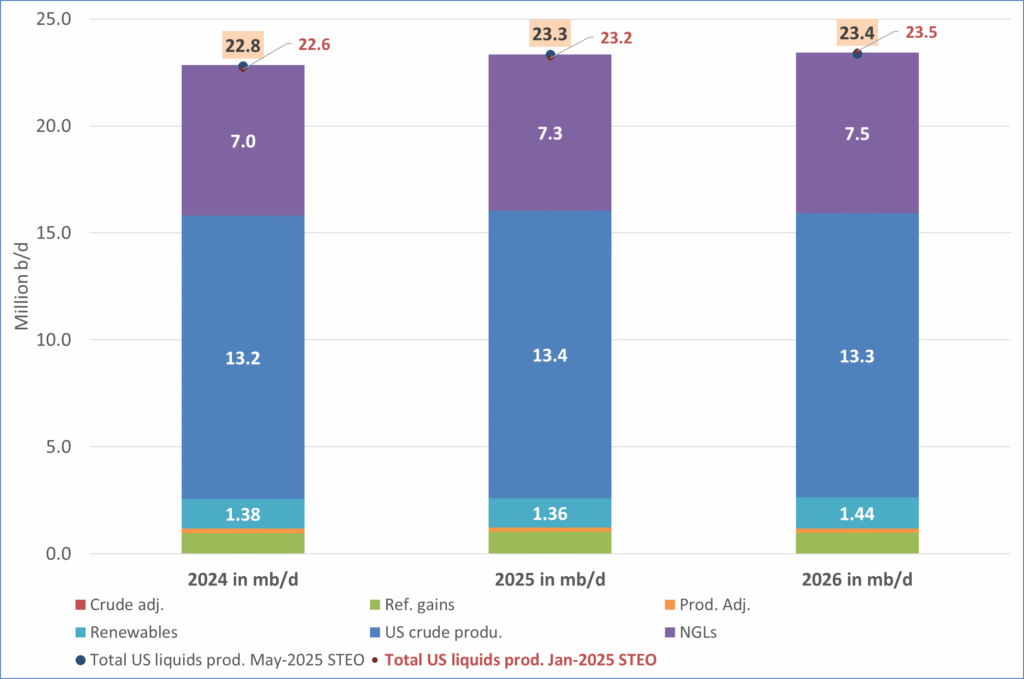
US IEA STEO September report. US crude oil production contracting in 2026, but NGLs still growing. Close to zero net liquids growth in total.
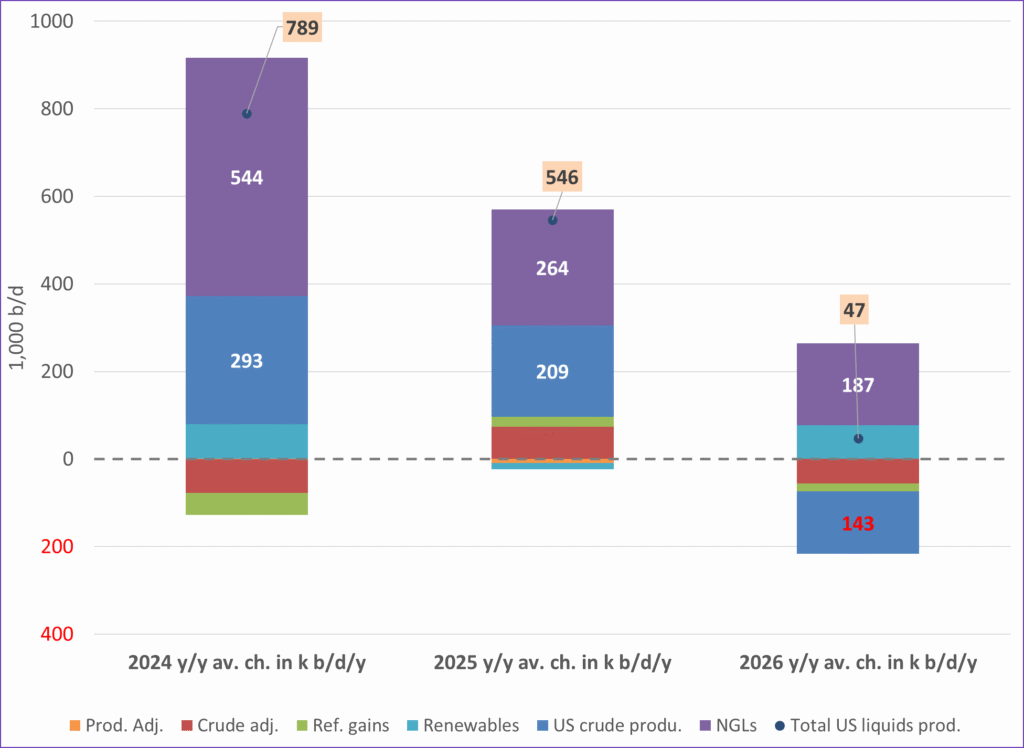
-

 Nyheter4 veckor sedan
Nyheter4 veckor sedanMeta bygger ett AI-datacenter på 5 GW och 2,25 GW gaskraftverk
-
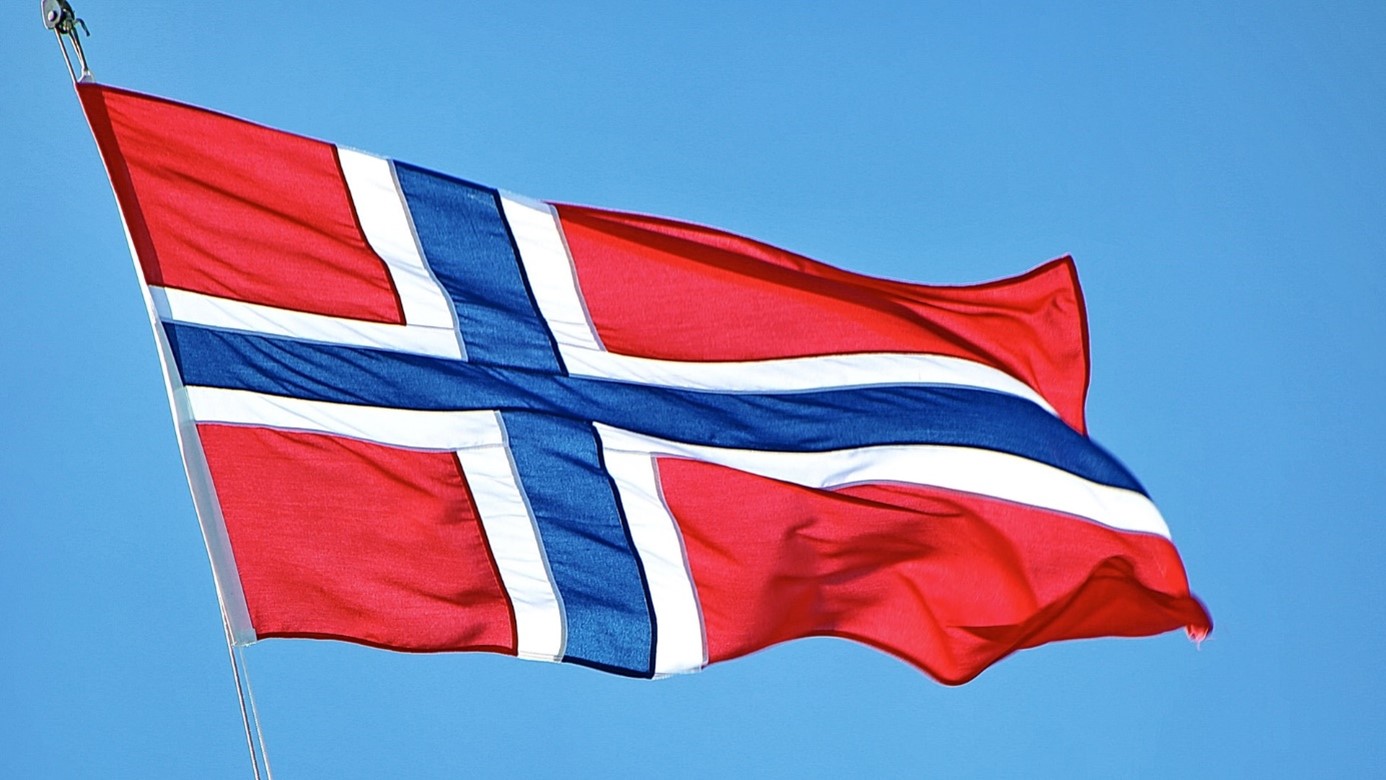
 Nyheter4 veckor sedan
Nyheter4 veckor sedanAker BP gör ett av Norges största oljefynd på ett decennium, stärker resurserna i Yggdrasilområdet
-

 Analys4 veckor sedan
Analys4 veckor sedanBrent sideways on sanctions and peace talks
-

 Nyheter4 veckor sedan
Nyheter4 veckor sedanSommarens torka kan ge högre elpriser i höst
-

 Analys4 veckor sedan
Analys4 veckor sedanBrent edges higher as India–Russia oil trade draws U.S. ire and Powell takes the stage at Jackson Hole
-
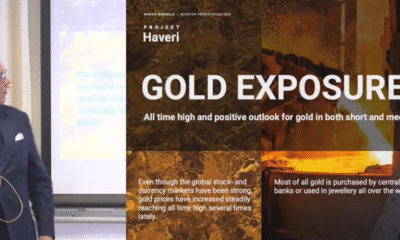
 Nyheter3 veckor sedan
Nyheter3 veckor sedanMahvie Minerals är verksamt i guldrikt område i Finland
-

 Analys3 veckor sedan
Analys3 veckor sedanIncreasing risk that OPEC+ will unwind the last 1.65 mb/d of cuts when they meet on 7 September
-
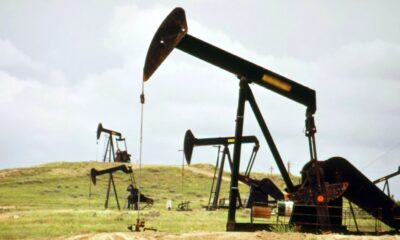
 Nyheter3 veckor sedan
Nyheter3 veckor sedanNeil Atkinson spår att priset på olja kommer att stiga till 70 USD



